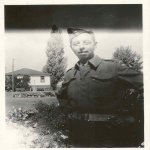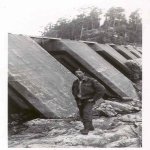One West Coast "zombie" brigade fought in the Aleutian Islands and were fully US equipped. Western training centres likely made use of that kit when the troops came home. There was also a division planned fur the invasion of Japan to be equipped with US kit which started training in the spring of 45.
Here's Canadian uniforms from both the Kiska invasion (Canadians kept their regular battledess and arms but did have some American equipment) and the 6th Division CAPF (Canadian Army Pacific Force) that was to be part of the Japan invasion force. The hexagon flash was either worn alone or sewn on top of a soldier's formation flash when he volunteered for the force. Its colours are red/blue/grey/green/maroon and black which represented the colours of Canada's 5 overseas divisions and its armoured corps. It's interesting that at the end of the war in Europe when Canadian troops were bored and really wanted to come home they offered to ship you ASAP providing you volunteered for the CAPF. A devil of a choice but one that paid off as the war in the Pacific ended and the volunteers were never needed.














































































